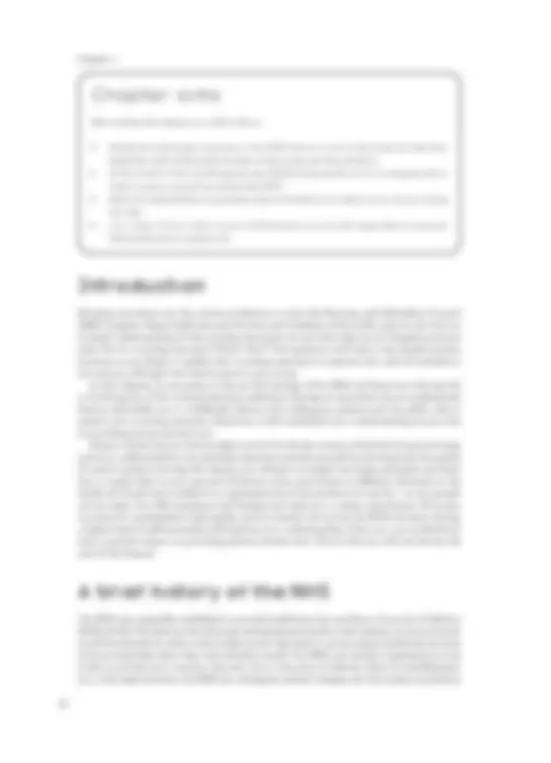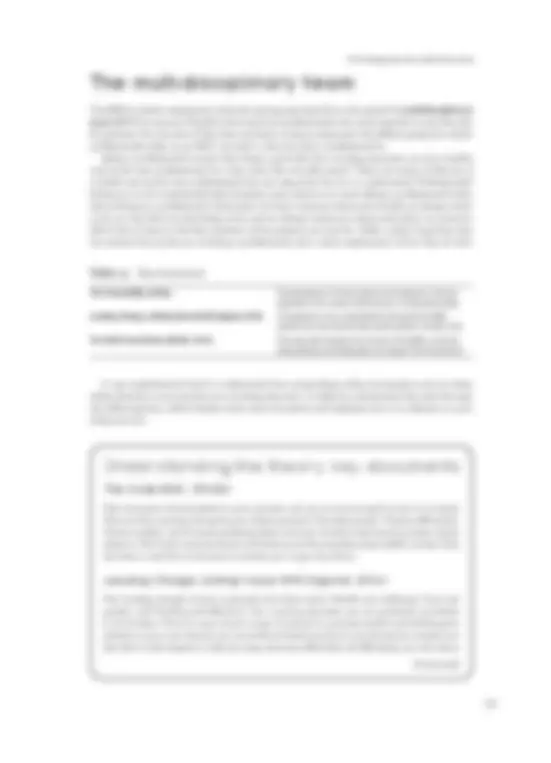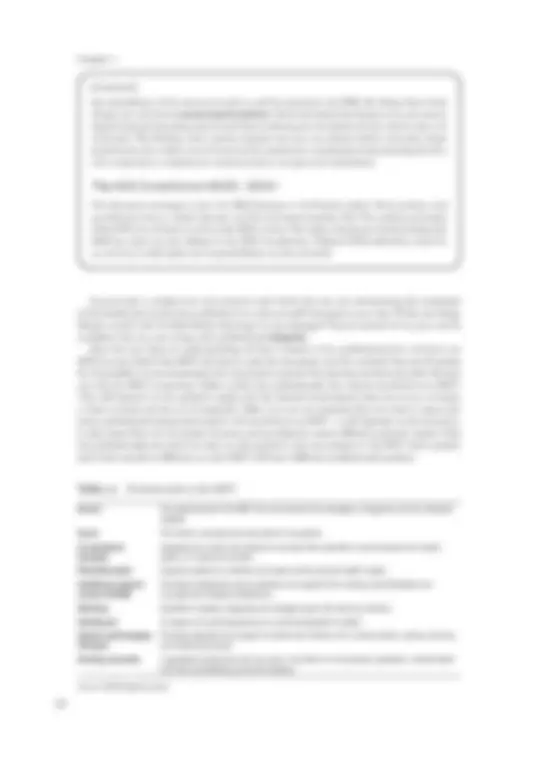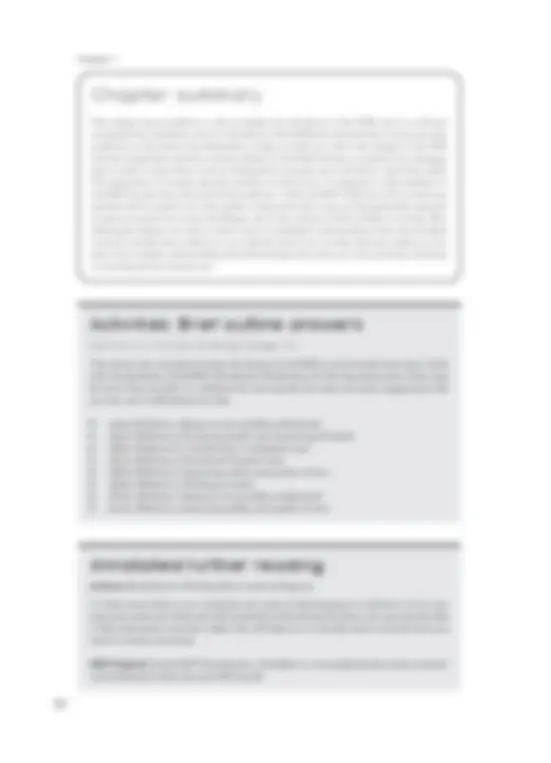











Study with the several resources on Docsity

Earn points by helping other students or get them with a premium plan


Prepare for your exams
Study with the several resources on Docsity

Earn points to download
Earn points by helping other students or get them with a premium plan
Community
Ask the community for help and clear up your study doubts
Discover the best universities in your country according to Docsity users
Free resources
Download our free guides on studying techniques, anxiety management strategies, and thesis advice from Docsity tutors
The history of the NHS and its impact on the formation of the nursing associate profession. It discusses the significance of person-centred care and the role of nursing associates in providing it. The document also covers the evolution of the NHS and the various milestones that have shaped its current structure.
Typology: Study notes
1 / 16

This page cannot be seen from the preview
Don't miss anything!










1
This chapter will address the following platforms and proficiencies: Platform 1: Being an accountable professional At the point of registration, the nursing associate will be able to: 1.1 understand and act in accordance with the Code: Professional standards of practice and behaviour for nurses, midwives and Nursing Associates, and fulfil all registration requirements 1.8 understand and explain the meaning of resilience and emotional intelligence, and their influence on an individual’s ability to provide care 1.9 communicate effectively using a range of skills and strategies with colleagues and people at all stages of life and with a range of mental, physical, cognitive and behavioural health challenges 1.10 demonstrate the skills and abilities required to develop, manage and maintain appropriate relationships with people, their families, carers and colleagues 1.11 provide, promote, and where appropriate advocate for, non-discriminatory, person-centred and sensitive care at all times. Reflect on people’s values and beliefs, diverse backgrounds, cultural characteristics, language requirements, needs and preferences, taking account of any need for adjustments
Providing person-centred care
Providing person-centred care it serves is very different. Table 1.1 is a timeline of significant events that have happened in the history of the NHS. Table 1.1 Timeline of the NHS Decade What happened? Why is this important for nursing associates providing person-centred care? 1940s • 1948: Establishment of the NHS by the then Minister of Health, Aneurin Bevan. The original three core principles of the NHS still guide its development today:
Chapter 1 Decade What happened? Why is this important for nursing associates providing person-centred care? 1980s • 1980: The Black Report recognised health inequalities.
Chapter 1 As a nursing associate, it is important for you to have an understanding of the micro- organisations that manage the NHS because the decisions they make directly affect your clinical practice. Complete Activity 1.2 to consolidate your understanding. Activity 1.2 (^) Reflection Rearrange the list in Table 1.2 into a thought cloud, starting with the NHS in the middle. Link all the different micro-organisations together to illustrate how the NHS management system is structured. As this activity is based on your own reflection, there is no outline answer provided at the end of the chapter. After completing Activity 1.2, you will have a clearer picture of how the NHS is managed. Your thought cloud may look complex, but this is a true representation of the systems in place that ensure the NHS meets the standards described in the NHS Constitution (DHSC, 2015). At this point, you have learned about the NHS’s past and present, but what about the future? What is next? Across England, there are trials of new systems of health and social care services, called vanguard sites. Vanguard sites aim to encourage organisations to work more closely together, including the collaboration of physical and mental healthcare needs, in sustainability and transformation partnerships (STPs). STPs are groups of organisations that work together to achieve the objective of vanguard sites; there are 44 in England. STPs aim to transition into integrated care systems (ICSs). ICSs work together with a joined budget to coordinate care and improve services for people who live in a particular community. In short, ICSs aim to manage the limited resources of the NHS more efficiently and provide continuity of care across their organisations’ services. This involves working with other bodies, such as local authorities, social care services and public health organisations, in order to drive up standards of service. What does all of this change mean for patients? Some services in the NHS are moving closer to patients to provide the care they need where most people would choose to be – at home. There is a substantial increase in support to improve and maintain good health, thus reducing the intense pressure on hospital services (King’s Fund, 2017). There are, however, some points for consideration. Regional health specialist services will become more common, which means that patients may need to travel further for specialised care. Moreover, the NHS will need to continue to change over the next few decades. Although more change may seem arduous, change is very much needed in the NHS because our patients continue to change. As a nation, we are living longer, with more complex care needs, so NHS services need to be able to meet new patient needs. Make sure you keep up to date with how the NHS is managed and the services that it provides throughout your career, as this will have an impact on your future as a nursing associate. See Chapter 8 for advice on how to keep your practice up to date and current.
Providing person-centred care The multidisciplinary team The NHS is clearly complex, but where do nursing associates fit in this system? A multidisciplinary team (MDT) is a group of health and social care professionals who work together to provide care for patients. You are part of this team and have a unique, important role. Before going into which professionals make up an MDT, we need to discuss what a professional is. Being a professional is more than doing a good job. As a nursing associate, you are a health and social care professional, but what does this actually mean? There are many attributes of a health and social care professional that are important for you to understand. Professionals’ behaviour is of a consistently high standard, even when not at work. Being a professional is also about being in a professional community: we have common values and morals, we always strive to do our very best in everything we do, and we always continue to learn and adapt our practice. All of this is done in the best interests of the patients we care for. Table 1.3 lists important key documents that guide you in being a professional, with a short explanation of how they do this. Table 1.3 Key documents The Code (NMC, 2018b) The standards of clinical practice and behaviour that are expected of all nurses, midwives and nursing associates. Leading Change, Adding Value (NHS England, 2016) A framework of ten commitments that guide the NHS workforce to provide the best quality person-centred care. The NHS Constitution (DHSC, 2015) This document explains the values of the NHS, including what patients and employees can expect from the service. It can sometimes be hard to understand how overarching policy documents such as these relate directly to your practice as a nursing associate. To help you understand this, read through the following box, which breaks down each document and explains how it is relevant to your daily practice. Understanding the theory: key documents
This document is fundamental to your practice, and you are encouraged to know it in depth. There are four sections that guide your clinical practice: ‘Prioritise people’, ‘Practise effectively’, ‘Preserve safety’, and ‘Promote professionalism and trust’. Another important document closely linked to The Code is the Standards of Proficiency for Nursing Associates (NMC, 2018a). Take the time to read this too because it outlines your scope of practice.
The ‘Leading change’ section is grouped into three topics: ‘Health and wellbeing’, ‘Care and quality’, and ‘Funding and efficiency’. As a nursing associate, you can positively contribute to all of these. First, it is part of your scope of practice to promote health and wellbeing for patients in your care. Second, you use evidence-based practice to provide person-centred care (see later in this chapter). Lastly, by using resources effectively and efficiently, you will reduce (Continued)
Providing person-centred care Attending an MDT meeting for the first time can make some people feel anxious because there might be a lot of people in the room. However, it is important to remember that everyone in the MDT is there to support each other, as well as supporting the patient in achieving their goals. Once you have been to a few MDT meetings, you will gain more confidence, and eventually you may contribute to the discussions. Whether you have been to one or many, attending an MDT meeting is a very useful learning opportunity because you gain an insight into the roles of other professions, as well as how they have a positive impact through providing person-centred care. Once you have attended an MDT meeting, complete Activity 1.3 to consolidate what you have learned. Do not limit yourself to completing this activity once, though. Each MDT meeting you attend will be different, so you can learn something new from each meeting you attend. Activity 1.3 (^) Reflection After attending an MDT meeting, think about your answers to the following questions:
Chapter 1 To explore the ideas outlined in the previous box, it may be of benefit to examine a specific example of a health condition. The following case study is based on a patient living with the common long-term condition asthma. Understanding the theory: social determinants of health Originally published in the seminal article by Dahlgren and Whitehead (1991), PHE (2017) explains that the social determinants of health are:
Chapter 1 the rationale (and evidence) behind an intervention, you could word your question as follows: ‘I’ve not seen this intervention before. I’m interested to know the evidence base behind it. Please could we go through it together?’ You can adapt this wording to suit the situation you are in; however, by asking the question in this way, you are demonstrating that you have professional curiosity, and the person you are speaking with is less likely to misinterpret you and feel you are being accusatory. In short, you are promoting teamwork and a learning culture in the area you are in. This has massive benefits for staff because people then feel they can ask questions and develop their practice. Moreover, patients benefit because the staff are working together to provide evidence-based care. Think back to earlier in this chapter when it was outlined that person-centred care means we critically analyse the positive and negative impacts on each patient we care for. By adopting this approach, you are thinking about the impact on the patients you are caring for, and therefore demonstrating person-centred care. Self-awareness Person-centred care is not solely about knowing your patient and what makes them an individual; you also need to know yourself. More specifically, you need to know and understand how you have an impact on the patient. The impact you make may be very positive; however, you must be cautious of making a negative impact on the patient. As you have been reading, each patient is unique because of their social determinants of health. Social determinants of health help us to understand each patient’s individuality in relation to their health; however, they can also help us to understand patients’ personalities. This also applies to you. Nursing associates can be patients, of course, but the more pressing point here is that your background defines you as a person, and by extension informs the choices you make and the personality you have. Your approach to a task may be completely different to that of one of your colleagues who completed the apprenticeship with you, despite the fact that you both studied at the same institution. Activity 1.4 explores this in a little more detail. Activity 1.4 (^) Reflection Consider how you approach writing an academic essay. Do you leave it all to the last minute, needing the pressure of an impending deadline? Or do you prefer to follow the recommended route of creating a structured study plan, completing the essay comfortably before the deadline, because you find this is a better way to manage your stress levels? Compare your thoughts with friends and colleagues. You may recognise that you are all completing the same task but have very different methods. As this activity is based on your own reflection, there is no outline answer provided at the end of the chapter. How do your reflections in Activity 1.4 relate to person-centred care? Consider the responses you received from your friends and colleagues, and how differently they interpreted the standardised process of writing an academic essay. Imagine the diversity of interpretations in the varied and high-pressured environment of clinical practice. The way that you and your colleagues
Providing person-centred care approach any task will inevitably be different. It is positive to have professional individuality because a diverse workforce is a reflection of the patients we care for; however, it is important to mitigate against possible negative effects on a patient. This should help you to understand why having increased self-awareness of your own strengths, weaknesses and preferences will help you and your colleagues to provide the best quality person-centred care. Diversity in the NHS workforce is clearly beneficial; however, let us refocus on how you can have an even greater positive impact on person-centred care. Working as a nursing associate is a privilege because you are in a position to care for people when they are at their most vulnerable, and they trust you to do so. We must recognise, however, that working as a nursing associate can be stressful and emotive due to the high pressure of caring for people when they are vulnerable. This leads on to another important point: you need to be continually conscious of your attitudes and behaviours because they affect other people. In other words, allowing yourself to choose a negative outlook will cause your colleagues and patients to do the same. Alternatively, actively ensuring that you have a positive attitude and behaviour will encourage others to adopt the same approach. This can be a very powerful force for good, especially if you meet a patient or colleague having a bad day. (It is worth remembering that it is likely your patients will almost always be having a worse day than you.) Read through the following box to help you understand how your attitudes and behaviours affect other people. Understanding the theory: Betari’s box Betari’s box is a tool you can use to illustrate how your own thoughts and actions have an effect on other people (Mind Tools, 2019a). This could be your colleagues, your patients, or even your friends and family after you arrive home from work. First, you need to identify your attitudes, which are determined by your feelings and/or prejudices. Next, you need to identify how your attitudes affect your behaviour. A note of caution: you must be honest with yourself about your behaviour. For example, you may naturally have strong facial expressions, so your thoughts and feelings are obvious to those around you. Ask a genuine friend or colleague if you are not sure. Your attitudes and behaviours then lead on to affect another person’s attitude. Lastly, the way you have affected someone’s attitude affects their behaviour. If you apply the process in Betari’s box to a clinical practice setting, you will be able to recognise if your attitudes and behaviours have a positive or negative effect on other people. In other words, your attitudes and behaviours may alter a patient’s attitudes and behaviours, which could lead to them making the wrong decision or feeling worse. A positive example would be actively listening to a patient who is depressed and demonstrating empathy, which may elevate their mood, thus supporting them in managing their depression. Regularly completing the process outlined in Betari’s box will help you to be mindful of your attitudes and behaviours throughout your career, as well as encouraging you to channel positivity into your clinical practice. Having consistently positive attitudes and behaviours will encourage others to have the same approach, including both your colleagues and patients. Positivity leads to an increase in efficiency and effectiveness, so the quality of patient care will increase. By choosing to practise in this way, you are choosing to promote person-centred care.
Providing person-centred care For more information about MDTs and the meetings they have, read this publication by NHS England. Price, B. (2019) Delivering Person-Centred Care in Nursing. London: SAGE. This book is an excellent introduction to person-centred care that has comprehensive content and a clear structure. Although it is intended for nursing students, much of the material is also relevant to nursing associate practice. Willis, P. (2015) Shape of Caring Review (Raising the Bar). Available at: www.hee.nhs.uk/ our-work/shape-caring-review This is the publication of an extensive review into the education and professional development of nursing and healthcare support workers following the Mid Staffordshire NHS Trust scandal. Useful websites 16Personalities Free Personality Test: www.16personalities.com/free-personality-test For an in-depth insight into your personality and characteristics, this website provides a free test based on the work of Myers and Briggs, which will help you to identify your strengths and areas for improvement.